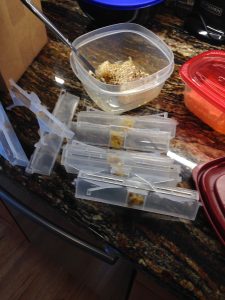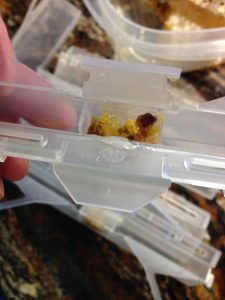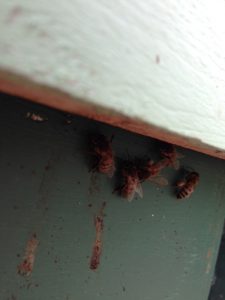If you did not make it to the last Siouxland Beekeepers meeting here is some of what you missed:
[jetpack_subscription_form]
I can’t believe it is the end of April and I have not had a chance to post yet. Spring gets really busy sometimes. We had some warmer than usual weather early in April and some colder than usual weather late in April. I went through all 4 hives and un-stacked the boxes to get to the bottom boards and clean them off. Over the coarse of winter the bottom board gets pretty dirty. Anything the bees discard falls to the bottom board and they do not have many chances to haul it outside when it is cold all winter. Mostly there are dead bees accumulating on the bottom board. Sometimes moisture will run down the sides of the hive and end up on the bottom board with the dead bees and other debris. It is a really good idea to get rid of all of this as soon as the weather is warm enough to take the hive apart temporarily (mid 60’s and sunny for a day or two). It is a good idea to keep some kind of cover on all the boxes as you work to retain some of the heat. There is brood in the hive at this time of year and if it gets too chilled it will die. So try to work fairly quickly.
While you are lifting boxes off, pay attention to how much they weigh so you know if the bees have enough stores or it you need to start feeding them sugar syrup. My hives had a bit of capped honey left this year and I actually saw fresh nectar in the hives from early blooming fruit trees. So I did not need to feed this spring.
Ma rch 19th was 78 degrees. Again, way warmer than normal for us. We have been having spurts of warmer than usual weather, followed by normal weather. It has been cool at night, sometimes below freezing. I think we have had just enough cool weather to keep the bees from trying to raise too much brood. At the same time it has not been so cold that they over taxed themselves keeping the brood warm. I checked the hives today and I found brood at all stages: Eggs, larva and capped pupa. We have been having this on and off unseasonably warm weather for 5 weeks now. It takes honeybees around 3 weeks, 21 days, to go from eggs to emerging new adult bees. So potentially there is already 2 weeks worth of new bees in each hive to help with the brood that is being raised now. Every day the chance of really cold weather gets less and less. So I am not as worried as I was about the bees freezing because there was too much brood they had to try to keep warm in a cold spell.
rch 19th was 78 degrees. Again, way warmer than normal for us. We have been having spurts of warmer than usual weather, followed by normal weather. It has been cool at night, sometimes below freezing. I think we have had just enough cool weather to keep the bees from trying to raise too much brood. At the same time it has not been so cold that they over taxed themselves keeping the brood warm. I checked the hives today and I found brood at all stages: Eggs, larva and capped pupa. We have been having this on and off unseasonably warm weather for 5 weeks now. It takes honeybees around 3 weeks, 21 days, to go from eggs to emerging new adult bees. So potentially there is already 2 weeks worth of new bees in each hive to help with the brood that is being raised now. Every day the chance of really cold weather gets less and less. So I am not as worried as I was about the bees freezing because there was too much brood they had to try to keep warm in a cold spell.
 The last time I checked the hives I noticed one of them had lots and lots of adult small hive beetles in it. They were running around on the same frames as the bees. No doubt they were keeping warm by hanging out right in there with the bees all winter. Small hive beetles are not too big a deal in their adult phase, but the larvae make a mess by eating honey and pollen and causing the honey to ferment. I am not sure when the adults will start laying eggs but I want to get rid of as many adults as I can before that happens. I recently read that the Small Hive Beetle Jail (www.dadant.com/catalog/m01543-baitable-beetle-jail-trap-each) can be baited with honey and pollen. The adults are attracted by the smell and the jail/trap is designed so the bees can’t get in and the beetles feel like it is an escape from the bees. I have some honeycomb that happens to have some cells of pollen in it. I thought I would try this out.
The last time I checked the hives I noticed one of them had lots and lots of adult small hive beetles in it. They were running around on the same frames as the bees. No doubt they were keeping warm by hanging out right in there with the bees all winter. Small hive beetles are not too big a deal in their adult phase, but the larvae make a mess by eating honey and pollen and causing the honey to ferment. I am not sure when the adults will start laying eggs but I want to get rid of as many adults as I can before that happens. I recently read that the Small Hive Beetle Jail (www.dadant.com/catalog/m01543-baitable-beetle-jail-trap-each) can be baited with honey and pollen. The adults are attracted by the smell and the jail/trap is designed so the bees can’t get in and the beetles feel like it is an escape from the bees. I have some honeycomb that happens to have some cells of pollen in it. I thought I would try this out. [jetpack_subscription_form] The bees were bringing in pollen on February 19th. You can see pollen baskets full on two bees in this photo. That is usually a sign they are raising brood. It may just be because the weather is really warm and the maple trees just started producing pollen, so the bees are loading up early while they have the opportunity. The forecast says we will be cooling off in a few more days. So hopefully they did not start too much new brood.
[jetpack_subscription_form] The bees were bringing in pollen on February 19th. You can see pollen baskets full on two bees in this photo. That is usually a sign they are raising brood. It may just be because the weather is really warm and the maple trees just started producing pollen, so the bees are loading up early while they have the opportunity. The forecast says we will be cooling off in a few more days. So hopefully they did not start too much new brood.
February 10th was unseasonably warm again. It was just over 55 degrees. I opened up the one hive that had already died and I found it had several frames of honey left. So they did not starve. There were not as many dead bees as I would normally expect to see, so I think the problem was there were not enough bees to survive the cold. They were in there and buzzing in late December, but we had a mild winter up to that time.
The good new is I can use the frames of honey in my other hives to make sure they all have enough to get through to spring. I peeked into the other 4 hives and found that only one of them really needed any honey. This is good news also.
It does not happen too often that you can check your hives in February. And it is not real often they have plenty of honey left this late in the winter. This could be a good beekeeping year.
The next issue to watch is this week of warm weather cumming now. If it is too warm for too long, the bees will start to raise young bees and then when it gets cold again they could exhaust themselves trying to keep the young bees warm.
[jetpack_subscription_form]
[jetpack_subscription_form]
How are my bees doing? Well January 18th was an exceptionally warm day for the middle of winter in Iowa and it gave me a rare opportunity to see the bees flying for the first time in around two months. It ordinarily needs to be above 50 or 55 degrees and sunny for the bees to be out and flying. This day it was only 45 degrees but the sun was pretty intense and it warmed up the hive boxes enough that some of the hives had bees out flying. It is good for the bees to get a chance to get outside of the hive and take a cleansing flight. They do not ‘go to the bathroom’ inside of the hive. So in the cold months of winter they have to ‘hold it’ until a warm day comes along. Two months is a long time for that, but it’s not uncommon here in the Midwest.
All in all the bees are doing OK. One hive looks like it has died though. Of the 5 I started the winter with it was the smallest. I had fed it sugar syrup in the fall but they just never put enough of it away. I tried to give them a couple of frames of honey in December but the cluster of bees was already at the top of the hive boxes and I could not open the hive without exposing them to too much cold air.
The remaining 4 hives should be OK until spring. They started winter with more honey, but I will need to start lifting each hive soon to judge how much honey they have left.
I took this short video of the bees flying in front of one hive. This is a top bar hive. The sound is mostly a tree service grinding up some tree limbs somewhere in the neighborhood. But some of the buzz is actually the bees!
https://www.youtube.com/watch?v=dke59wus8S0
[jetpack_subscription_form]
These are some important things I would point out to anyone who is gearing up with new equipment. Some of these things will be harder than others to change to once you have hives up and running. So if you have not started beekeeping yet, give them some careful consideration before you start buying equipment. You may save yourself a lot of work later on.
Even if small cell has not been proven to help with mites, there is no doubt that 5.4 mm foundation is larger than the bees would naturally draw themselves. If you let the bees draw their own combs they will get down around 4.9 mm (this can take a few cycles). The up-sizing must have some effect, even if we do not know what that effect is!
Since you can now buy small cell foundation, the only concern I can think you may have is, will the bees you buy be able to draw out the small cell foundation. From personal experience I have had package bees draw out 4.9 mm plastic frames with no problems. 4.9 mm foundation should also work just as well.
If you start out with small cell foundation or small cell plastic frames then later you can switch to foundationless and your bees will draw small cell on their own. You just have to wait until the young bees that draw comb are the same bees that were raised in the small cell foundation or small cell plastic frames. Since a brood cycle takes 21 days about four or five weeks should be long enough.
If you start with large cell and switch to foundationless your bees will draw something inbetween large cell and small cell. You would then need to take those frames away from the bees and make them draw out foundationless again to get down to small cell. This may take several cycles and lots of work to get down to 4.9 mm.
There is a lot of information out on the web on small cell. Some of the best is on Michael Bush’s website at: www.bushfarms.com/beesnaturalcell.htm

Honeybees drawing out a frame of honeycomb with no foundation in the frame.
There have been studies done that show the number of chemicals that accumulate in beeswax. It is surprising how many and how much is in the wax. This is also true of the foundation you buy. As a treatment free beekeeper I do not want to use foundation as I feel it has too much contamination already. So I use foundationless frames and let the bees draw out what they want. Before I started I read that it is hard to get the bees to draw frames straight without some kind of guide. So I compromised and used 50% foundatiionless frames and 50% plastic small cell frames that have been sprayed with wax (MannLake PF-120s). You can now get the PF-120s without wax and add your own clean wax.
If you start with foundation you can rotate those frames out after you go foundationless, but the chemicals may not have stayed put and may be in your foundationless combs now. In my opinion once the chemicals are in the hive they do not come out, not very quickly anyway. So the sooner you can get to foundationless and the less contaminated wax you must use to get there, the better off you are.
By the way: You must level your hives if you go foundationless. Also don’t try to mix foundationless frames and plastic frames by alternating them in the same hive box. The bees will draw the foundationless out extra wide and ignore the plastic frames!
Again Michael Bush has more info on his website at: http://www.bushfarms.com/beesfoundationless.htm
The standard 1 & 3/8 frames are wider than what the bees would use on their own. Given the choice, bees will draw out the brood nest with combs spaced 1 &1/4 inch center to center. This is probably more important if you go with small cell. Since the small cell bees are smaller it takes even more of them to fill the space between combs. This increase in frame width also increases the space between combs since the bees will draw the comb in the brood nest out to the same thickness no matter how far apart the frames are. Again, like the increased cell size, there must be some effect on the bees, but I have not heard much talk about it.
Walter T Kelly sells narrow frame equipment. www.kelleybees.com/index.html
If you start with standard width frames you can rotate them out later as you replace them with narrow frames. You can use your old wide frames in the honey supers, but if they had brood in them this can affect the flavour of the honey.
Here is a link to Michael Bush’s page on narrow frames: http://www.bushfarms.com/beesframewidth.htm
8 frames are lighter. That’s my only reason. The weight difference between an 8 frame box of honey and a 10 frame one may be more that you think! (43 pounds vs 55 pounds) I have heard some say the size and shape of an 8 frame hive is closer to a hive in a hollow tree and may help the bees in colder winters.
If you start with 10 frame equipment you can always switch to 8 frame by just moving frames into new 8 frame boxes. But you will have all those 10 frame boxes left over and nothing to do with them. (They make great bait hives for trapping swarms though!)
Mediums are lighter than deeps. 8 frame mediums are 15 pounds lighter than 8 frame deeps and 10 frame mediums are 17 pounds lighter than 10 frame deeps. But weight is only part of the reason I use them. It is so much more convenient to have all of your frames the same size. When winter comes and you need to make sure the brood nest has honey frames on the outside you can just take frames from the honey supers and move them there. If your brood nest is deep frames, you need to find deep frames of honey for this. If you did not plan ahead and use some deep boxes for honey supers then you won’t have deep honey frames to use when winter rolls around.
If you need to give a hive a frame of brood, maybe for them to raise an emergency queen from, medium frames of brood translate to less of a setback for the hive you take it from.
The other thing I think is an advantage is the winter cluster has more opportunity to cross frames if the hive is in 3 mediums than if it is in 2 deeps. Three mediums are almost the same size as two deeps, just an inch or so bigger.
If you start with deeps you can always switch from deeps to mediums later, you just end up with deep boxes AND deep frames you no longer need. (Again they make great bait hives for trapping swarms!)